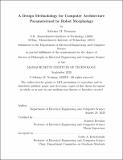| dc.contributor.advisor | Srinivas Devadas. | en_US |
| dc.contributor.author | Neuman, Sabrina M. | en_US |
| dc.contributor.other | Massachusetts Institute of Technology. Department of Electrical Engineering and Computer Science. | en_US |
| dc.date.accessioned | 2021-01-06T20:17:22Z | |
| dc.date.available | 2021-01-06T20:17:22Z | |
| dc.date.copyright | 2020 | en_US |
| dc.date.issued | 2020 | en_US |
| dc.identifier.uri | https://hdl.handle.net/1721.1/129301 | |
| dc.description | Thesis: Ph. D., Massachusetts Institute of Technology, Department of Electrical Engineering and Computer Science, September, 2020 | en_US |
| dc.description | Cataloged from student-submitted PDF of thesis. | en_US |
| dc.description | Includes bibliographical references (pages 113-122). | en_US |
| dc.description.abstract | Robots that safely interact with people are a promising solution to address societal challenges from elder care to hazardous work environments. A key computational barrier to the robust autonomous operation of complex robots is running motion planning online at real-time rates and under strict power budgets. A performance gap of at least an order of magnitude has emerged: robot joint actuators respond at kHz rates, but promising online optimal motion planning for complex robots is limited to 100s of Hz by state-of-the-art software. While domain-specific hardware accelerators have improved the power and performance of other stages in the robotics pipeline such as perception and localization, relatively little work has been done for motion planning. Moreover, designing a single accelerator is not enough. It is essential to map out design methodologies to keep the development process agile as applications evolve. | en_US |
| dc.description.abstract | We address these challenges by developing a generalized design methodology for domain-specific computer architecture parameterized by robot morphology. We (i) describe the design of a domain-specific accelerator to speed up a key bottleneck in optimal motion planning, the rigid body dynamics gradients, which currently consumes up to 90% of the total runtime for complex robots. Acceleration is achieved by exploiting features of the robot morphology to expose fine-grained parallelism and matrix sparsity patterns. We (ii) implement this accelerator on an FPGA for a manipulator robot, to evaluate the performance and power efficiency compared to existing CPU and GPU solutions. We then (iii) generalize this design to prescribe an algorithmic methodology to design such accelerators for a broad class of robot models, fully parameterizing the design according to robot morphology. | en_US |
| dc.description.abstract | This research introduces a new pathway for cyber-physical design in computer architecture, methodically translating robot morphology into accelerator morphology. The motion planning accelerator produced by this methodology delivers a meaningful speedup over off-the-shelf hardware. Shrinking the motion planning performance gap will enable roboticists to explore longer planning horizons and implement new robot capabilities. | en_US |
| dc.description.statementofresponsibility | by Sabrina M. Neuman. | en_US |
| dc.format.extent | 122 pages | en_US |
| dc.language.iso | eng | en_US |
| dc.publisher | Massachusetts Institute of Technology | en_US |
| dc.rights | MIT theses may be protected by copyright. Please reuse MIT thesis content according to the MIT Libraries Permissions Policy, which is available through the URL provided. | en_US |
| dc.rights.uri | http://dspace.mit.edu/handle/1721.1/7582 | en_US |
| dc.subject | Electrical Engineering and Computer Science. | en_US |
| dc.title | A design methodology for computer architecture parameterized by robot morphology | en_US |
| dc.type | Thesis | en_US |
| dc.description.degree | Ph. D. | en_US |
| dc.contributor.department | Massachusetts Institute of Technology. Department of Electrical Engineering and Computer Science | en_US |
| dc.identifier.oclc | 1227704903 | en_US |
| dc.description.collection | Ph.D. Massachusetts Institute of Technology, Department of Electrical Engineering and Computer Science | en_US |
| dspace.imported | 2021-01-06T20:17:22Z | en_US |
| mit.thesis.degree | Doctoral | en_US |
| mit.thesis.department | EECS | en_US |
